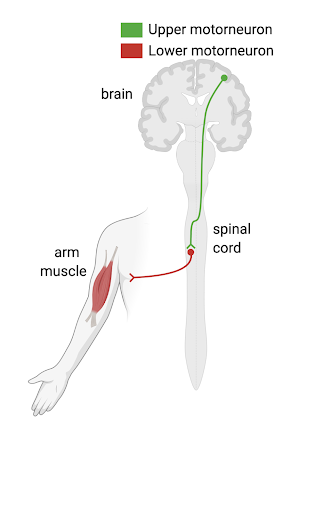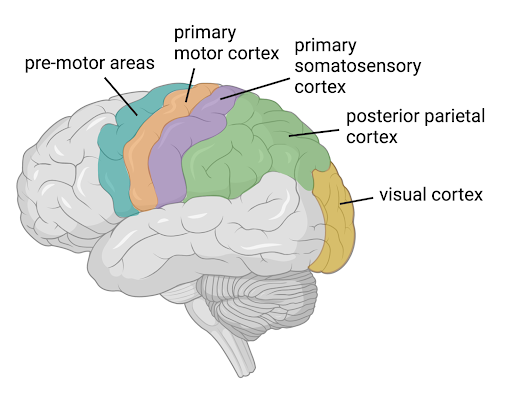How does the brain control movements?
For background information, see how does the brain process information?.
We are often impressed by the ability of elite athletes to control their movements in ways that seem impossible, and to make it look easy. However we rarely appreciate our own abilities to button our shirts or tie our shoes. These kinds of dextrous tasks cannot be performed by any other animal, nor by the most advanced robotic systems. A large portion of our brain activity is dedicated to controlling our muscles, even though we usually make movements easily without thinking. This post will describe how some parts of your brain allow you to perform your incredible skills!
The brain sends signals to the spinal cord
Neurons in the brain control movements by sending signals through long axons that reach the spinal cord. Motor neurons in the spinal cord then transmit these signals directly to muscles to activate them. The shortest paths between the brain and muscles only require information to travel through 2 neurons. These direct paths allow us to make precise and quick movements. Injuries to the spinal cord can interrupt these paths between the brain and muscles, causing paralysis.

The motor cortex is specialized for movement
Most of the movement signals sent from the brain to the spinal cord come from the primary motor cortex, which is a section of the wrinkly sheet of tissue on the surface of the brain called the cerebral cortex. The organization of the human primary motor cortex was charted in detail by Wilder Penfield in the 1930s at the Montreal Neurological Institute. Penfield performed brain surgeries to remove small areas of the brain that were causing seizures in epilepsy patients. In order to find the right area, Penfield applied mild electrical currents to different parts of the brain. Only local anesthesia was used, and patients were awake so they could report the sensations and experiences caused by stimulation to different brain areas! Electrical stimulation of the primary motor cortex caused body movements and muscle twitches. Stimulating any particular part of the primary motor cortex caused movement in a specific part of the body. In this way, the primary motor cortex is organized into a “motor map” of the body. Body parts that are near to each other are controlled by nearby areas of the motor cortex.
Pre-motor areas of the cortex are found in front of the primary motor cortex. Damage to these areas can result in very unusual phenomena. For example, people with damage to the supplementary motor cortex sometimes reach out and grab objects automatically even if they have no reason or intention to do so. They may feel as if their hand is acting without them controlling it at all. This strange disorder is called alien hand syndrome. Pre-motor areas have less direct control over muscles than the primary motor cortex. Instead, pre-motor areas are important for selecting and planning the appropriate movement for a particular situation, and for organizing sequences of actions.

Sensory brain areas are essential for movement
Although the motor cortex is specialized to control movements, many other parts of the cerebral cortex must work together to coordinate actions. Our movements are guided by our senses of vision, touch, and body position. The visual cortex processes sensory information from our eyes, while the somatosensory cortex is vital for body senses. Information from both of these areas is transmitted to the posterior parietal cortex where it is combined to form a spatial awareness of the body and its position in the world. This area plays an important role in visuomotor transformation, the process by which the brain selects a target using vision and generates the movements necessary to reach that target.
The brain is extremely good at learning visuomotor transformations, even ones that might seem very unnatural. For example, the brain can form a sense of 3D space in a video game world even while looking at flat images on a screen. We learn to hit targets in this virtual space by moving a joystick with our thumb, even though the video game world and the joystick exist in two totally different spaces. The ability to learn almost any visuomotor transformation may be what makes humans so good at using tools.

Deep brain areas help select and control actions
Areas of the brain below the cerebral cortex also participate in movement. The motor cortex sends information to the cerebellum and the basal ganglia. Both of these structures send signals back to the motor cortex, forming “loop” circuits that affect the signals that the motor cortex sends down to the spine to produce movements. The basal ganglia are thought to help the cortex to select and initiate the movements that we intend to produce, while blocking us from making other unwanted actions. The cerebellum makes adjustments to the speed, timing, and force of movements that make it possible to produce precise skillful actions.

Next, check out how do we adapt our movements and learn new skills?.